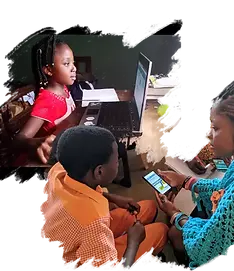The Oppia Foundation
Oppia is a learning platform that provides online math lessons to students aged 7–14 in low socioeconomic status regions. The platform also supports contributors such as teachers and volunteers.
My roles
Content Designer, Content Manager, Content Strategist, Technical Writer
Collaborated with
Product Designers, UX Researchers, Product Managers, Social Media Marketers, and non-profit leaders and stakeholders


This project highlights my ability to:
-
Design for equity by prioritizing accessibility, localization, and inclusivity
-
Translate pedagogical goals into engaging, gamified experiences
-
Conduct and apply content-focused research to align language with user needs
-
Build sustainable content frameworks and mentor others in applying them
-
Deliver measurable impact for learners in underserved communities
Duration
Apr 2023–Apr 2024 (1 year)
Impact
-
Users who completed Oppia math practiced sessions saw a 69% increase in their grades.
-
Contributors who completed product tours saw a 53% increase in ease of adoption compared to those who did not.
-
Identified 3 high-friction terms and improved comprehension accuracy by 18% through cloze and comprehension testing.
Challenges
-
Inconsistent tone and plain language across the platform, creating barriers for low-literacy and ESL learners
-
Confusing taxonomy that hindered both users and internal contributors
-
Under-utilized style guide with limited guidance for content designers and UX writers
-
Lesson user journeys offered little incentive for learners to continue beyond completion
-
Contributor and creator tools were clunky and unintuitive
Solutions and process
-
Implemented consistent, accessible language across three dashboards (Learner, Contributor, Creator)
-
Designed instructional product tours for contributors, reducing onboarding confusion and empowering volunteers
-
Partnered with designers to create gamified practice sessions, writing motivational copy and IA flows
-
Enhanced the Oppia content style guide with accessibility, localization, inclusivity, and taxonomy sections
-
Developed a research plan using cloze testing to evaluate learner comprehension and nomenclature preferences
-
Created resources to grow Oppia’s content practice, including taxonomy docs, slide decks, and handouts for junior team members
Contributor dashboard - product tours
The Oppia code base was limited in how much freedom designers and content had to suggest optimization for a better user experience.
As such, we devised a series of product tours to help our contributors understand how to:
-
Submit questions to help learners practice skills they're learning
-
Translate text to help multilingual learners
Working alongside product designers, I crafted product tours and instructional copy to help contributors navigate the platform, including "try it out" features as part of the tour.
My work improved contributor onboarding, reduced confusion, and empowered a broader community to engage with and grow the platform.
Contributors who completed product tours saw a 53% increase in ease of adoption compared to those who did not.
Brief tour - hover overs

Portion of the full tour - the goal was to help volunteers create effective practice questions and enable better learning outcomes for learners

How to translate lessons - tour


Ensuring localization and accessibility
Oppia's primary targets are low literacy, ESL users. As such, I led efforts to refine platform content guidelines with a focus on accessibility and localization.
The aim was to simplify complex concepts using plain language principles, ensure clarity across reading levels, and collaborate with other teams to make content translation-ready.
Style guidance - Localization


Style guidance - Accessibility


Gamified practice sessions
I contributed to the copy, information architecture, and overall user experience of a new gamified practice session.
In doing so, I focused on:
-
Balancing clarity with engagement by designing intuitive flows
-
Writing motivational in-game prompts
-
Aligning UI copy with cognitive load best practices
The result was a more playful, accessible experience that encouraged independent practice and sustained user attention.
Surveyed users later reported 69% improved their grades after completing this new lesson structure.




Learner nomenclature cloze testing research plan
A recurring issue I noted during my time at Oppia was that we were using several terms that were confusing to both our users and internal base.

Working with UX researchers, I developed a plan to test preferred nomenclature among young learners, using cloze testing to evaluate comprehension and engagement with key terms. The goal was to identify language that felt intuitive and age-appropriate across different reading levels.
Through this research, we identified 3 high-friction terms to retire, thereby improving comprehension accuracy by 18%.


Furthering the Oppia content design practice
As a content design lead, I contributed to growing the Oppia content design practice by creating resources to support junior team members and cross-functional partners.
In addition to the style guide additions mentioned previously, I developed:
-
A taxonomy of terms to help teams better understand and correctly implement Oppia-specific concepts
-
A slide deck on how content design fits into the broader UX process
-
Instructional handouts outlining methods for conducting content-focused research.
These materials helped standardize best practices and strengthen content design's role across the organization.


